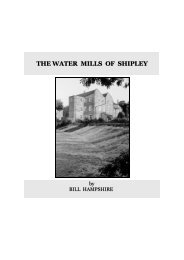IN THE SHADOW OF THE ROSSE - Shipley
IN THE SHADOW OF THE ROSSE - Shipley
IN THE SHADOW OF THE ROSSE - Shipley
Create successful ePaper yourself
Turn your PDF publications into a flip-book with our unique Google optimized e-Paper software.
CHAPTER EIGHT<br />
The creation of the <strong>Shipley</strong> Local Board of Health in 1853, and the powers specifically<br />
given to the Board to control all new developments in the town, meant that from that<br />
time on, all houses erected in <strong>Shipley</strong> had to be built to a certain minimum standard.<br />
The Local Board were also required to ensure that there was sufficient ventilation,<br />
within and around the houses; also that they were provided with a decent water supply<br />
and adequate sewerage facilities. The planning records of the <strong>Shipley</strong> Local<br />
Board, and the later Urban District Council, show that such powers were taken seriously,<br />
and many original plans were rejected for breaches of the bye-laws on these matters.<br />
Naturally, the standards and requirements for new buildings changed over the years,<br />
both in terms of local and national legislation. But the most controversial of all were the regulations<br />
regarding back-to-back house. Such houses had been a traditional way of providing<br />
homes for low paid industrial workers in many parts of the country throughout<br />
previous centuries. Though by the second half of the nineteenth century it had become<br />
accepted by most public health experts, and many local authorities, that living in such<br />
houses meant a poor standard of health for their occupiers.<br />
For example, a study by the Local Government Board into the health of residents of<br />
such houses, compared with those of through houses, suggested that there was an increase<br />
of between 15 and 20 percent in the death rates of the occupiers of back-tobacks.<br />
29 Although it could be argued that the people most likely to be living in such<br />
houses were among the poorest within any district, and that, as such, they would be<br />
more susceptible to debilitating illnesses anyway. Also, as George Sheeran has pointed<br />
out, opposition to such houses from the medical profession was based on the false medical<br />
theory of miasma. 30 Nevertheless, many local authorities in other parts of the country<br />
had outlawed such houses.<br />
However, <strong>Shipley</strong>, and many other towns within the West Riding continued to defend<br />
the right of builders to put up back-to-back houses despite national and<br />
county pressures to outlaw them. 31 Indeed, the pressure on the council from the<br />
developers was so great that they were sometimes coerced into breaking their own<br />
bye-laws. For example, during the course of 1892, <strong>Shipley</strong> council was in regular<br />
correspondence with the solicitor of the West Riding County Council and the<br />
Local Government Board in London, over the councils wish to pass plans for a new<br />
block of back-to-back houses in Belgrave Square which were said to be in contravention<br />
of such bye-laws. 32<br />
The evidence from Ordnance Survey maps show that a large number of homes<br />
built in <strong>Shipley</strong> during the last thirty years of the nineteenth century were back-tobacks.<br />
And this, despite the example from Saltaire, that through houses were a viable,<br />
and even a minimum requirement for decent housing - though there were even<br />
a few back-to-backs at the bottom end of Saltaire village, which survived until the<br />
1930s.<br />
The largest development of back-to-backs in <strong>Shipley</strong> can be seen to have been in the<br />
area bounded by St. Paul’s Road, Manor Road and Westcliffe Road, where over 450<br />
26



